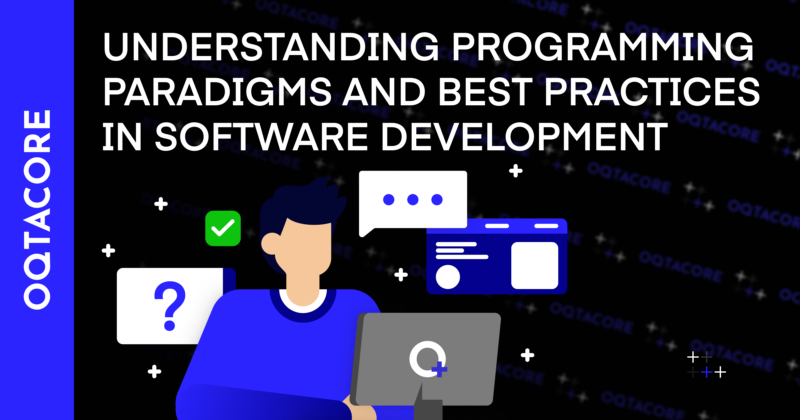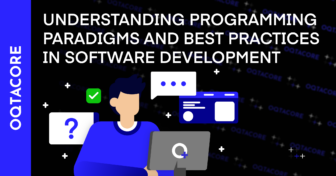
In the ever-evolving world of software development, choosing the right programming paradigm plays a crucial role in how efficiently you can build, scale, and maintain your project. Whether you are developing a Web3 application, blockchain-based system, or any modern software solution, understanding different programming paradigms can help shape the future of your project.
This article delves into the three main programming paradigms – Object-Oriented Programming (OOP), Functional Programming (FP), and Procedural Programming – and discusses how developers can leverage these approaches to build scalable, maintainable, and high-performance applications.
What Are Programming Paradigms?
A programming paradigm defines the style or approach used to write software. It dictates how programs are structured, how data flows through the application, and how the developer interacts with that data.
Object-Oriented Programming (OOP)
Object-Oriented Programming (OOP) is the dominant paradigm in modern software development, accounting for 99.9% of all code. It organizes code around objects that encapsulate both data and behavior. This approach allows for better modularity, reusability, and maintainability, making it the most popular choice for large-scale software applications.
Example:
Let’s say we are creating a simple program to simulate visiting a store. In OOP, we would represent the store, the actions, and even the items as objects. Here’s an example:
python
Copy
class Store:
def __init__(self, name, price):
self.name = name
self.price = price
def buy_item(self, item):
print(f"Buying {item} from {self.name} for {self.price}.")
class Person:
def __init__(self, name):
self.name = name
def go_to_store(self, store, item):
print(f"{self.name} is going to the store.")
store.buy_item(item)
store = Store("SuperMart", 20)
person = Person("Alice")
person.go_to_store(store, "Milk")
In this code, Store and Person are objects, and their actions (like buy_item) are methods that define their behavior.
Functional Programming (FP)
Functional Programming (FP) is a paradigm where computation is treated as the evaluation of mathematical functions and avoids changing state or mutable data. This paradigm is particularly useful in scenarios where concurrency and predictability are important, such as blockchain applications and data processing.
Example:
Consider the task of calculating the total price of items in a cart:
python
Copy
def calculate_total(cart):
return sum(cart)
cart = [20, 15, 30]
total = calculate_total(cart)
print(f"Total: {total}")
Here, calculate_total is a pure function that takes the cart and returns a result without altering any external state. FP promotes immutability and pure functions, making it easier to reason about and test the code.
Procedural Programming
Procedural Programming is based on the concept of procedures (or functions) that operate on data. It focuses on writing sequences of instructions to perform tasks. While this approach is less common in modern software development, it’s still widely used for simpler systems.
Example:
In procedural programming, tasks are written as a sequence of steps:
python
Copy
def buy_item(item, price):
print(f"Buying {item} for {price}.")
def go_to_store(item, price):
print(f"Going to the store to buy {item}.")
buy_item(item, price)
go_to_store("Milk", 20)
The main difference between procedural and OOP is that there is no data encapsulation. Functions are separate from the data they operate on.
Functional Programming: Simplifying Complex Logic
Functional programming was one of the earliest programming paradigms. Let’s imagine a simple process: a child learning to speak. They express ideas using simple constructs, similar to how functional programming relies on expressions to perform actions.
Simple Example:
arduino Copy Mother went to the store. Mother bought milk. Mother placed milk in the bag. Mother came home.
These statements are expressions – complete commands on their own. By breaking down the problem into small functions, we can make complex logic more manageable.
Object-Oriented Programming (OOP): Structuring Code
As software projects grew more complex, the need for a more modular and scalable approach became apparent. OOPwas created to organize code around real-world objects, allowing developers to reuse code more effectively. For example, rather than having separate functions for entering a store, buying items, and paying in multiple parts of the program, you group those functions into an object (e.g., Store or Person) to keep everything organized.
Why Object-Oriented Programming Is Key for Scalability
In an increasingly complex project, such as a blockchain application or a decentralized exchange (DEX), managing growing amounts of code requires OOP principles. By breaking down logic into objects with clear responsibilities, OOPprovides:
- Modularity: Code is more organized and easier to maintain.
- Reusability: Objects can be reused across the system, making updates and changes simpler.
- Scalability: New functionality can be added with minimal disruption to existing code.
Handling Complexity in Large Projects
In larger projects, complexity can spiral out of control. As more developers work on the same codebase, maintaining clarity and consistency becomes harder. Enter frameworks – prewritten code that provides solutions to common tasks and accelerates development.
Example: A Dynamic Web Framework
As an example, let’s say our “store” system grows more complex. We can refactor our solution using a framework like React (for frontend) or Django (for backend) to simplify complex logic and ensure scalability.
Managing Code with Gitflow
In large teams, managing code changes efficiently is crucial. Gitflow is a version control strategy that ensures a smooth workflow and minimizes conflicts.
How Gitflow Works:
- Branching: Developers work on individual branches based on the features they are developing.
- Code Reviews: After completing work, the branch is reviewed by other developers.
- Merging: After review, the branch is merged back into the main branch and deployed.
This structure allows teams to work independently without stepping on each other’s toes, reducing conflicts and ensuring that the project remains organized.
Conclusion: The Importance of Choosing the Right Paradigm and Tools
When developing Web3 applications, choosing the appropriate programming paradigm – whether OOP, FP, or procedural programming – depends on the project goals and the complexity of the application. As Web3 projects grow, OOP remains the go-to choice for building modular, scalable systems, while functional programming can simplify concurrency and data-driven logic.
Moreover, the tools, frameworks, and version control strategies (such as Gitflow) play a significant role in managing complexity and maintaining high code quality. In the fast-paced world of Web3 development, a well-structured codebase ensures not only functionality but also scalability, security, and maintainability for long-term success.
Explore More About Software Development:
- Choosing the Right Programming Language in 2025
- Understanding Layer-1 and Layer-2 Blockchains
- Understanding Tech Stacks in Web3 Development
